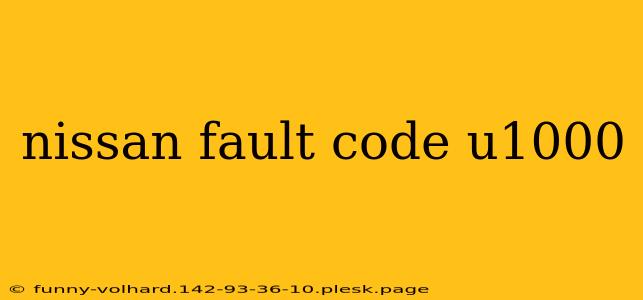The dreaded check engine light illuminates, and your Nissan displays the fault code U1000. Panic sets in. What does it mean, and how serious is it? This comprehensive guide will break down Nissan fault code U1000, helping you understand the problem, potential causes, and troubleshooting steps.
What Does Nissan Fault Code U1000 Mean?
U1000 is a generic trouble code indicating a loss of communication within the vehicle's network. This isn't a specific problem with a single component, but rather a failure in the communication between the various Electronic Control Units (ECUs) within your Nissan's complex network. Think of it as a breakdown in the car's internal messaging system. Because the problem lies in the communication itself, pinpointing the exact source can be challenging.
This code signifies that the vehicle's central computer (often called the Body Control Module or BCM) can't communicate effectively with at least one other ECU. Many systems rely on this communication, leading to a range of potential symptoms depending on which ECUs are affected.
Common Causes of Nissan Fault Code U1000
Several factors can contribute to this communication failure. Identifying the root cause often requires systematic troubleshooting:
1. Faulty Wiring and Connectors:
-
Damaged Wires: Worn, frayed, or corroded wires within the vehicle's network can disrupt communication. This is particularly common in older vehicles or those exposed to harsh environmental conditions. Look for physical damage to wiring harnesses, especially near areas susceptible to wear and tear.
-
Loose or Corroded Connectors: Connections between ECUs are crucial. Loose or corroded connectors can prevent proper signal transmission. Inspect all connectors for cleanliness and secure connections. Corrosion can often be cleaned with a contact cleaner.
2. Faulty ECUs:
A malfunctioning ECU itself can prevent communication with other units within the network. While less common, a failed ECU is a possibility and might require professional diagnosis and replacement.
3. Issues with the CAN Bus System:
Many modern vehicles, including most Nissans, use a Controller Area Network (CAN) bus system for communication between ECUs. Problems with this CAN bus, such as a faulty CAN bus transceiver or short circuit, can cause a U1000 code.
4. Low Battery Voltage:
Insufficient battery voltage can sometimes disrupt communication within the network. A weak or failing battery should be checked and replaced if necessary.
Troubleshooting Nissan Fault Code U1000
Attempting to fix a U1000 code requires a methodical approach:
-
Inspect Wiring and Connectors: Begin by visually inspecting all wiring harnesses and connectors for any signs of damage, corrosion, or loose connections. Pay close attention to areas prone to wear and tear.
-
Check Battery Voltage: Ensure the battery is supplying sufficient voltage. A low battery can cause intermittent communication problems.
-
Clear the Code: After addressing any potential issues, clear the trouble code using an OBD-II scanner. Then, test-drive the vehicle to see if the code returns.
-
Professional Diagnosis: If the code persists, seek professional help from a qualified mechanic. They possess the diagnostic tools necessary to pinpoint the precise location of the communication failure, potentially involving advanced diagnostic software to analyze data streams between ECUs.
Preventing Future U1000 Codes
Regular vehicle maintenance can help prevent future occurrences of U1000:
- Routine Inspections: Periodically check wiring harnesses and connectors for signs of wear and tear.
- Battery Maintenance: Maintain your battery's health through regular charging and testing.
- Professional Servicing: Adhere to Nissan's recommended service intervals.
Remember, attempting repairs without proper knowledge and tools can potentially worsen the issue. If you're unsure about any step of the troubleshooting process, always consult a qualified mechanic. A U1000 code can point to a range of problems; a professional diagnosis is crucial for accurate and timely repair.

